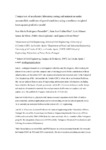Mostrar o rexistro simple do ítem
Comparison of accelerated laboratory curing and maturation under uncontrolled conditions of gravel emulsions using a nonlinear weighted least-squares predictive model
| dc.contributor.author | Pasandín, A.R. | |
| dc.contributor.author | Galán-Díaz, Juan José | |
| dc.contributor.author | Silva, Luís M. S. | |
| dc.contributor.author | Orosa, Pablo | |
| dc.contributor.author | Pérez Pérez, Ignacio | |
| dc.date.accessioned | 2023-11-14T16:32:33Z | |
| dc.date.available | 2023-11-14T16:32:33Z | |
| dc.date.issued | 2022 | |
| dc.identifier.citation | Rodríguez Pasandín, A. M., Galán-Díaz, J. J., da Silva, L. M. S., Iglesias, P. O., Pérez, I. P. (2022). Comparison of accelerated laboratory curing and maturation under uncontrolled conditions of gravel emulsions using a nonlinear weighted least-squares predictive model. International Journal of Pavement Engineering, 1-11. https://doi.org/10.1080/10298436.2022.2144309 | es_ES |
| dc.identifier.uri | http://hdl.handle.net/2183/34204 | |
| dc.description | Versión aceptada de autora e autores | es_ES |
| dc.description.abstract | [Abstract:] Cold-asphalt mixtures (CAMs) are evolved materials whose mechanical strength increases with their maturation. The relationship between CAM field maturation and laboratory-accelerated cure procedures is not well understood. Furthermore, there is controversy on the recommended methodology for laboratory-accelerated cure. So, in this work, the accelerated curing protocol for a CAM-type gravel emulsion was examined, and its uncontrolled maturation and performance were contrasted. For this, the mixture was subjected to either accelerated curing (from 0 to 7 days in a 50 °C oven) or natural curing (from 0 days to 6 months at 20 3 °C in the laboratory and at an unfixed temperature outside the laboratory). We analysed, as functions of time, the moisture, indirect tensile stiffness modulus (ITSM), and moisture damage resistance. A curing protocol of 2 days at 50 °C yielded ITSM values closer to those obtained under uncontrolled conditions. Nevertheless, total maturation of the mixture was achieved after 3.5 days of curing. The nonlinear weighted least-squares method yielded an expression that better predicted the performance of the gravel emulsion for the first six months of life. The model parameters were easily fitted using ITSM measurements derived from samples cured for 2 days in a 50 °C oven. | es_ES |
| dc.description.sponsorship | The EMULCELL project was co-financed by the Centre for Industrial Technological Development (CDTI), the Ministry of Economy and Competitiveness-Government of Spain, and the European Regional Development Fund (FEDER) (Ref. IDI-20171097). The authors would also like to thank ‘Repsol’ and ‘Áridos de Astariz’ for kindly providing the necessary materials to carry out the research. | es_ES |
| dc.description.sponsorship | Ministerio de Economía y Competitividad; IDI-20171097 | es_ES |
| dc.language.iso | eng | es_ES |
| dc.publisher | Taylor & Francis | es_ES |
| dc.relation.uri | https://doi.org/10.1080/10298436.2022.2144309 | es_ES |
| dc.rights | Atribución-NoComercial-SinDerivadas 3.0 España | es_ES |
| dc.rights.uri | http://creativecommons.org/licenses/by-nc-nd/3.0/es/ | * |
| dc.subject | Cold-asphalt mixture | es_ES |
| dc.subject | Gravel emulsion | es_ES |
| dc.subject | Evolutive material | es_ES |
| dc.subject | Uncontrolled maturation | es_ES |
| dc.subject | Accelerated curing protocol | es_ES |
| dc.subject | Nonlinear weighted least squares | es_ES |
| dc.title | Comparison of accelerated laboratory curing and maturation under uncontrolled conditions of gravel emulsions using a nonlinear weighted least-squares predictive model | es_ES |
| dc.type | info:eu-repo/semantics/article | es_ES |
| dc.rights.access | info:eu-repo/semantics/openAccess | es_ES |
| UDC.journalTitle | International Journal of Pavement Engineering | es_ES |
| dc.identifier.doi | 10.1080/10298436.2022.2144309 |
Ficheiros no ítem
Este ítem aparece na(s) seguinte(s) colección(s)
-
CITEEC-CGM - Artigos [93]






